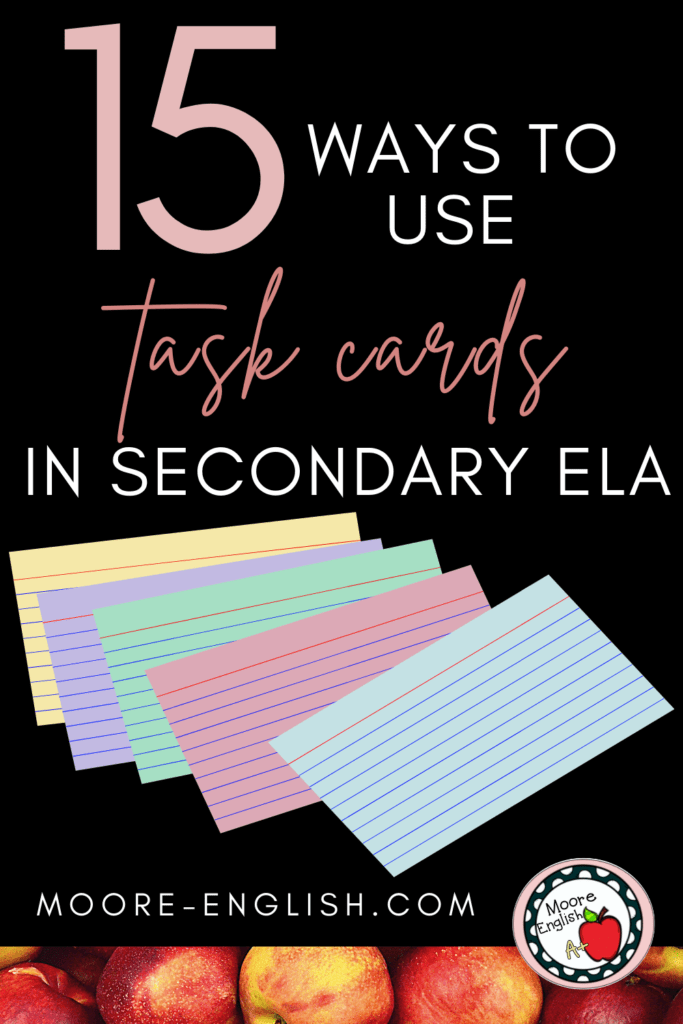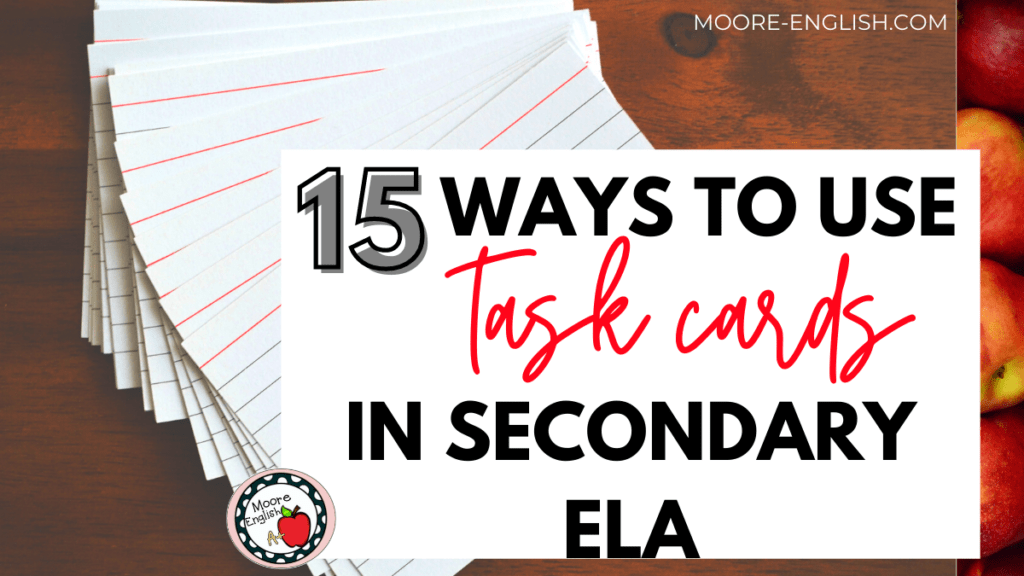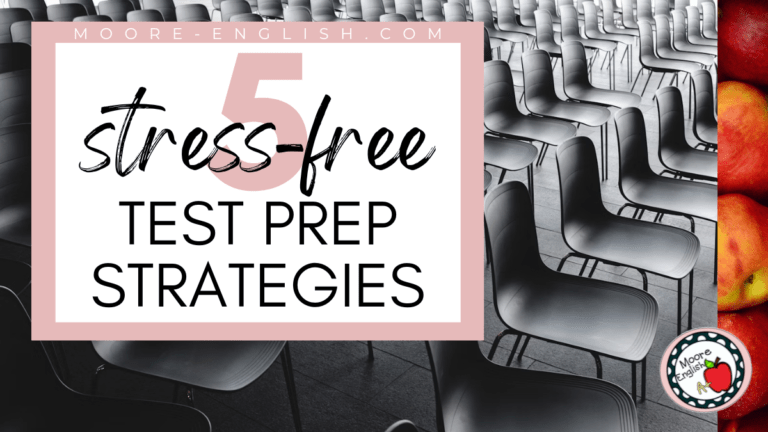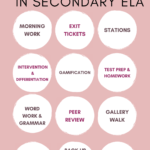I have to admit that when I first read about task cards, I dismissed them as an elementary tool. However, over time, I have come to love using task cards in my secondary language arts classroom!
Today, I want to share 15 ways to use task cards in secondary ELA! Some of these strategies can be mixed together or used individually. Just choose the strategy and the cards that work for you and your students!
This post this post may contain affiliate links. Please read the Terms of Use.
Grammar Task Cards
When I first became interested in task cards, I was preparing to teach freshmen for the first time in ages. Knowing that I would need to engage ninth-grade students in grammar, I designed several sets to help them learn, practice, and review different grammar concepts. Here are some of my favorite grammar resources:
- Nouns Card Sort
- Adverbs Card Sort
- Conjunctions Card Sort
- Adjectives Catchphrase
- Indefinite Pronoun Card Sort
- Free Sentence Types Card Sort
Vocabulary Review and Acquisition
In addition to using daily context clues, I am always looking for opportunities to improve my vocabulary instruction. Task cards are easy to make, so they’re perfect for vocabulary instruction! Since they are flexible, teachers can quickly make task cards that suit any word list or vocabulary set! Here are some vocabulary cards I love:
Gamification
For my students, task card games are an absolute favorite! While there are countless ways to gamify with task cards, my students LOVE to race. Depending on the topic, they can have task card races in teams or individually. All you have to do as the teacher is decide how many “legs” or cards are involved in the race, whether or not there will be a time limit, and what “prize” the winning team will earn! Here are some of my favorite games to use with students:
- Free Paragraph Sorts
- Text Features Concentration
- Source Credibility and Bias Card Sort
- Steps in the Research Process Card Sort
Task Cards for Morning Work and Exit Tickets
Entering and exiting the classroom are essential classroom procedures! While I draw on a variety of bell work and journals for starting class, task cards can also be part of a great morning routine. At the beginning of the day, the teacher decides if she wants students to all address the same card for bell work or different cards.
If students are addressing the same task card, simply project it on the board or post it to Google Classroom. If students are addressing different cards, they can grab one off the stack by the door, or you can take the time to leave specific cards for specific students.
Similarly, teachers can also use task cards as formative assessment! Check out these sets that feature exit tickets!
- Tone Game and Exit Tickets
- Mood Game and Exit Tickets
- Appositives and Audience Awareness Exit Tickets
Inquiry-based Learning
Inquiry-based learning is a great way to help students learn concepts and vocabulary. In a previous post, I described how to use inquiry-based learning to introduce sonnets. With task cards, teachers can also use inquiry-based learning to introduce new concepts and vocabulary.
For me, this strategy has worked well teaching my sophomores about parallelism and teaching my juniors about aphorisms. Knowing that neither group has learned about these techniques, I give students a stack of cards featuring examples of parallel structure or aphorisms. Then, students use those examples to work backwards to arrive at a definition of the new term. This strategy always evokes intense emotions from students, which means these are terms and ideas they never forget!
Try inquiry-based learning today with these free cards to help students define heroism!
Task Cards Create Movement
Adding movement is a wonderful way to help students engage with content. Teachers can use task cards as a way to generate movement and connect students with content! Here are three of my favorite ways to incorporate movement in the classroom!
Firstly, Gallery Walks get students up and moving! With task cards, choose what you want students to view in the “gallery,” and you’re ready to go!
Secondly, Question Trails are a good way to use cards that feature multiple-choice questions, multiple steps, or cards that build on one another.
Thirdly, Stations provide students with a clear structure for movement. Of these options, stations are probably my favorite activity because they build on a familiar procedure and provide me with small group work time.
Sponge Activity and Back-Up Plan
Unsurprisingly, sometimes things in the classroom do not go according to plan. For this reason, it’s essential to have sponge activities for those odd minutes between classes. This is an easy way to fill unexpected time.
Similarly, when classroom technology fails, task cards are an easy tool because they are reliable and flexible.
Homework and Test Prep
While teaching during the pandemic, I relied heavily on digital activities. Some of my traditional homework and test prep is paper heavy, so I pivoted in both areas. This turned out to be a blessing! Since these cards are lightweight and flexible, they are easy to send with students as homework. Similarly, they make for easy and ready-made test prep!
Task Cards for Intervention and Differentiation
When I first set out to use task cards, I underestimated their utility in differentiating content. With this strategy, I can easily choose which students address which cards to differentiate for the needs of unique learners. Similarly, I can also decide how students respond and in what setting. Some classes may use cards in small groups, some in partners, and some as individuals.
With all of this in mind, task cards also become a high-leverage opportunity for intervention. In a guided reading group, cards can become a good way to drill down to student needs. Additionally, they can target specific skill gaps!
Peer Review
Finally, task cards are a good option for peer review. In traditional peer review, students often struggle to identify their strengths and the needs of their classmates. With this set of peer review task cards, students are “experts” in certain areas while they look for advice, suggestions, and insights into other areas of their writing. This is a good strategy for incorporating movement, building community, and developing student self-efficacy!
Create Your Own
As I have learned over the years, more often than not, the exact resource my students needs isn’t always out there. Sometimes it’s better to just make my own resource (which is how I started Moore English in the first place). With this free task cards template, teachers can design their own task cards without having to fuss with the formatting.
Alternatively, teachers can share this Google Slides resource with their students and ask students to design their own cards! Given clear expectations, students generate engaging, challenging tasks and questions they can share with one another!
Bottom Line
Overall, task cards are a flexible, diverse tool that can strengthen and support instruction in a variety of areas. This includes grammar, vocabulary, writing, and reading! With this, teachers can try gamification, incorporating movement in the classroom, and building student skills!
Check out all of my task card resources!















